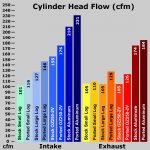Over the past few years we've flow tested several Australian 250-2V cylinder heads, as well as our own Aluminum cylinder heads. However we've always wondered how the cast iron "log heads" stacked up, not only to the Australian and Aluminum heads, but to each other, both in stock and modified configurations. Therefore we decided to do a little work on the flow bench.
Since we already had flow numbers from an Australian 250-2V cylinder head and our aluminum head, both in stock and modified configurations, all we had to do was flow test both log heads in roughly the same configurations for a good heads-up comparison. Unfortunately the only small log cylinder head we had in our possession had already been modified and converted to a 2V intake, so we had to guesstimate the stock numbers.
All four of the modified heads included over-sized valves, and were ported in a street/strip configuration. Both the OZ and Aluminum head were tested with the 2V manifolds installed, while the modified log heads were tested with the 2V conversion adaptors installed. I should also note that we tested the #2 ports on all four cylinder heads. All heads were tested at 28" H2O.
The one thing I found interesting, is that with our experience modifying and porting log heads, we were able to get a modified large log to flow nearly as well as a stock OZ250-2V, which I always assumed was impossible.
Summary: We pretty much concluded that it's not worth putting money into a small log head. Even with larger valves and port work, the small log won't flow as well as a stock large log head. So if your going to use a log style head, and you want to increase performance, buy a used large log head and put your money into it. You'll be better off in the long run, and a lot happier with the end results.
For those who'd like more information, I'm working on a tech article that will cover everything in detail, it's just not done yet. However, I'd thought I'd share the peak flow numbers in the mean time. The next step is to spend some time on an engine dyno, which may happen next month if I can afford it.
Here's the peak numbers in a bar graph.

Since we already had flow numbers from an Australian 250-2V cylinder head and our aluminum head, both in stock and modified configurations, all we had to do was flow test both log heads in roughly the same configurations for a good heads-up comparison. Unfortunately the only small log cylinder head we had in our possession had already been modified and converted to a 2V intake, so we had to guesstimate the stock numbers.
All four of the modified heads included over-sized valves, and were ported in a street/strip configuration. Both the OZ and Aluminum head were tested with the 2V manifolds installed, while the modified log heads were tested with the 2V conversion adaptors installed. I should also note that we tested the #2 ports on all four cylinder heads. All heads were tested at 28" H2O.
The one thing I found interesting, is that with our experience modifying and porting log heads, we were able to get a modified large log to flow nearly as well as a stock OZ250-2V, which I always assumed was impossible.
Summary: We pretty much concluded that it's not worth putting money into a small log head. Even with larger valves and port work, the small log won't flow as well as a stock large log head. So if your going to use a log style head, and you want to increase performance, buy a used large log head and put your money into it. You'll be better off in the long run, and a lot happier with the end results.
For those who'd like more information, I'm working on a tech article that will cover everything in detail, it's just not done yet. However, I'd thought I'd share the peak flow numbers in the mean time. The next step is to spend some time on an engine dyno, which may happen next month if I can afford it.
Here's the peak numbers in a bar graph.


